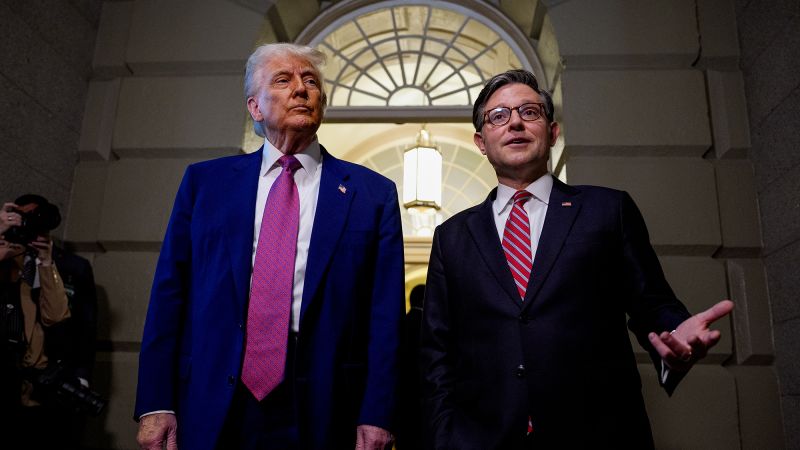President Donald Trump’s recent push to consolidate Republican support around his economic agenda has been underscored by a stark warning from the bond market, which appears to be signaling apprehension about his significant tax legislation known as the “Big, Beautiful Bill.” The bill recently passed the House of Representatives, marking a notable victory for the White House and its Republican allies. However, the passage also reignited persistent concerns regarding the stability of the US financial system. This anxiety was reflected in a sharp sell-off of Treasury bonds, as investors assessed the dangers posed by projections that the legislation could add trillions to the national debt.
The rapid rise in bond yields, reaching levels not seen in nearly two decades, has afflicted long-term borrowing costs, serving as a dire cautionary signal for Trump’s legislative objectives. This sentiment has been echoed by several of Trump’s associates and voiced publicly by Steve Bannon, a prominent adviser who warned that the bond market “gets a vote” in economic outcomes, cautioning against allowing the market’s reactions to dictate U.S. decisions. Bannon expressed concerns that unmanageable debt levels could jeopardize the country’s financial autonomy.
Even as yields on 30-year Treasury bonds began to stabilize, the looming threat of a bond market revolt overshadowed Trump’s legislative priority, which the White House is intent on moving through the Senate. The recent developments sharpen the dilemma facing Trump and Congressional Republicans, as the success of the entire economic agenda hinges on the passage of this tax and spending bill. Yet, that same passage has the potential to trigger overwhelming resistance from the bond market, which might disrupt the administration’s broader strategy.
The tax bill represents one leg of what is known as Trump’s three-legged economic plan, alongside tariffs and spending cuts; if any one of these foundational components falters, the entire structure risks collapsing. The loss of tax incentives or deregulation could severely limit the government’s ability to motivate businesses towards planning, investment, and reshoring efforts resulting from the extensive tariffs imposed by the Trump administration. Without these tax cuts, American consumers could find themselves ensnared in a high-cost, tight-credit economic environment.
Such adverse outcomes could further erode political support for the Republicans and significantly diminish their chances of retaining congressional majorities. If the GOP fails to recalibrate, which seems unlikely, it risks inflicting additional strain on American consumers. This potential pain could resonate with anyone holding credit cards, car loans, student loans, or mortgages, as these financial products are typically linked to bond yields, which have been on an upward trend.
Additionally, bond rates are not only influential on individual borrowers but also on corporate credit and can affect the pricing of financial assets globally, along with America’s reputation as a safe haven for investors. This perception was dampened when Moody’s downgraded the U.S. credit rating from AAA, implying a risk in lending to a heavily indebted nation.
On his influential podcast, Bannon emphasized that such deficits indeed matter, pointing out that individuals should be conscious of how market rates impact their financial commitments. The House’s approval of Trump’s tax bill marked an argument in favor of Trump’s dominance within the Republican Party and progress toward achieving his economic goals. Yet, the subsequent sell-off in bonds and spike in long-term borrowing costs raised alarm that this legislative win could be a Pyrrhic one, signaling economic instability.
The intricacies of these financial events have left many in the economic world feeling unsettled, with one Wall Street executive commenting on the excessive uncertainty that now blankets the largest economy globally. While Trump has thrived amid uncertainty—turning it into leverage in urgent trade negotiations—such unpredictability consequently places American businesses in a state of planning paralysis, imposing long-term costs on the country’s economic stature.
Fears of rising bond rates that could initiate an unthought-of economic spiral further exacerbate these concerns. Although the worst-case scenario is viewed as remote, the stakes remain high. Treasury Secretary Scott Bessent articulated the risks, noting that a deterioration in debt sustainability could lead to an abrupt halt in economic activity as market confidence evaporates.
It’s crucial to acknowledge that while the worst outcomes may be improbable, so too is the realization of all positive scenarios for Trump’s economic vision. A swift succession of bilateral trade agreements could alleviate initial tariff-related anxieties, bringing certainty to trade dynamics, while rising tariff revenues may allay concerns about increasing deficits from the proposed tax bill.
For businesses, the successful enactment of the tax cut may instill confidence, potentially reinstating corporate investment and restoring belief in the U.S. economy’s vitality. However, the interdependent nature of Trump’s economic policies means that if one aspect falters, it could lead to a domino effect, undermining his broader ambitions.
The Trump administration, navigating through its chaotic trade policy rollout and dealing with a tax bill lacking in robust growth incentives, faces considerable challenges ahead. For all of Trump’s apparent strengths in navigating political opposition, the bond market remains an entity immune to executive authority,



